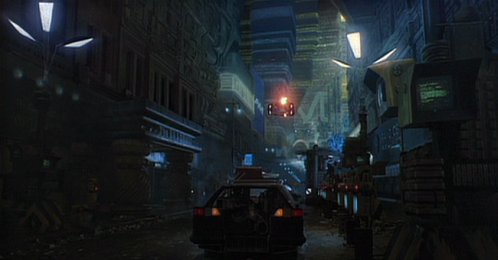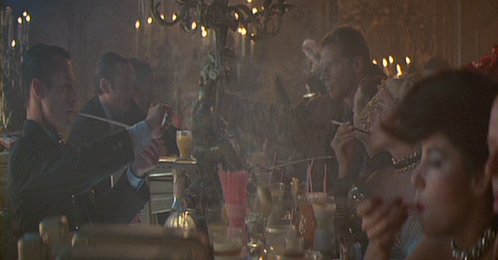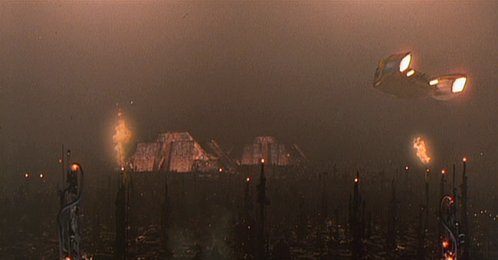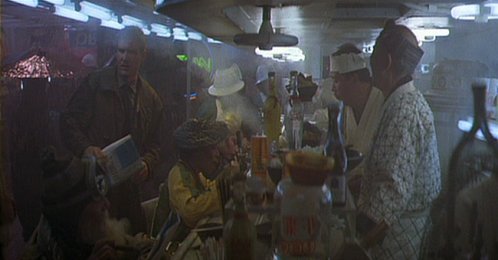Urban oppressor-nation parasites anxious about the future:
"Blade Runner"

"Blade Runner" (http://www.imdb.com/title/tt0083658/)
("Blade Runner: The Director's Cut")
Directed by Ridley Scott
PG-13 / Argentina:16
1982
(1992)
Reviewed by a contributor
Retired "blade runner" Rick Deckard (Harrison Ford) is "little people" according to his former boss, and subject to being recalled by the government for further police work, but this reviewer did not get the impression that Deckard was somehow an exploited worker or an oppressed nationality. Deckard is a celebrated, veteran police worker, an unambiguous unproductive sector worker, and "Blade Runner" makes it clear right from the start that it is the "replicants" who are "Off-world" [in outer space] working as slave labor, in the hazardous exploration and colonization of other planets."
"Blade Runner" is similar to the movie "Brazil" (1985) in this respect. The protagonist in each movie is the enemy socially speaking since they are both economic parasites and doing government or police work of some kind under capitalism. It is not because of their line of work that they seem to be oppressed (in fact, they are not oppressed), but because they live in a society that glorifies individualism at the same time it subjects everyone to the capitalist state and seemingly invincible economic and social forces. This reviewer would not go as far as saying that everyone in the world has an interest in the revolution, but it remains a "paradox of oppressor cultures that many of the parasites themselves face empty lives which seem out of their individual control."(1) In this context, "Blade Runner" has the potential to neutralize some parasites politically. It depicts the angst and despair of some Euro-Amerikans who live in a "dystopia" that bears an uncanny resemblance to today's deeply antisocial society, but it does not suggest that most Euro-Amerikans are oppressed economically.

"Blade Runner" does have the potential to neutralize a few parasites politically. However, the net impact of "Blade Runner" is hard to tell. The historical context in which "Blade Runner" came out is relevant here. "Blade Runner" is set in Los Angeles, 2019, but it appeared in 1982, during the "white flight" to suburbia that was still going on in many parts of the united $tates, after the mid- 1970s recession, and during the restructuring of the u.$. economy, and the Los Angeles economy in particular, away from heavy industry. We can't discount the possibility of a reflexive relationship between these changes, in particular, white flight, and the prevailing movie culture of the time. Currently, "Blade Runner" is considered to be "one of the most influential films ever made."(2)
Euro-Amerikan settlement
There is a blatant settlement theme in "Blade Runner" that resonates strongly with the foreboding visual images of hellish urban dystopia. A blimp video advertisement, paid for by a corporation "helping America into the new world," encourages people to move to the off-world colonies and settle there. "A new life awaits you in the off-world colonies, the chance to begin again in a golden land of opportunity and adventure." The blimps are promoting settlement, not just tourism, and entice people with offers of their very own persynal Replicant workers, to dispose of however they wish. Euro-Amerikans are competing with other oppressor nationalities for territory in outer space.
Replicants, however, badly want to leave the off-world colonies. They had rebelled in the off-world colonies before, but were put down, and now they are risking death by breaking immigration laws and taking their battle to the belly of the beast, the united $tates.
Replicants, genetically engineered humynoids with artificially shortened life spans are exploited slaves in the off-world colonies. So, it is disturbing that they are the only villains in the movie. The escaped Replicants appear to be little more than homicidal psychopaths who victimize the head of the Tyrell Corporation among others.
Bourgeois humanism
We know little about the Replicants' lives in the off-world colonies. The colonies don't even appear in any scene. The Replicant leader Roy Batty tells the Cantonese-speaking genetic engineer who designs eyes (James Hong), "If only you could see what I have seen with your eyes." Vague comments such as this and pure sentiment are all that we're given to understand the Replicants' history. Evidently, what the Replicants have actually experienced is unimportant. The ending of "Blade Runner" becomes a "humanist" lesson on the value of experience in general, and experience as a humyn quality.

One of the movie's biggest take-home messages is that it is wrong to repress people who are trying to assert their humyn identity. In contrast, MIM would say that it is criminally wrong to repress exploited and oppressed people regardless of whether they've had any interesting, or unique, persynal experiences or memories. The Replicants led by Roy are right to fight their way to the top of the Tyrell Corporation in order to save their lives, and they are right to kill Dr. Tyrell if that actually prevents the creation of more short-lived, expendable Replicants in the slave system. The Replicants are not justified simply because they are being denied their humynity in some ahistorical and abstract sense. They are justified because they are exploited and oppressed, and are facing death themselves.
"Blade Runner" does little to show how exploitive systems are wrong in general. While large, the Tyrell Corporation's development and manufacturing operations seem to be confined to Los Angeles and vicinity. "Blade Runner" is a comment on the "unethical" practices of a particular monopoly and of a particular government that does not permit Replicants to live among humyns on Earth. If the Tyrell Corporation really is as large as, say, the Umbrella Corporation in Resident Evil: Apocalypse" (2004), it should be able to exert influence on government policy to allow at least some Replicants to work among humyns on Earth. The local economy depicted in "Blade Runner" is largely a Hooters-type capitalist economy. There is a potential place for the Tyrell Corporation's pleasure models in this economy.
The economy of 2019 Los Angeles
How the fantastic amounts of concrete, lighting, liquor and infrastructure that appear in the movie are produced isn't touched on. There is little attempt to understand monopoly capitalism in general, and no attempt to understand how the majority of the imperialist-country population, particularly Euro- Amerikans, is involved in parasitism. This is true even though "Blade Runner" does not depict the average Euro-Amerikan employee as being exploited or victimized by monopoly capital. Just failing to show the police attacking the general population does not do enough to show how the vast majority of Euro-Amerikans obtain net benefits from u.$. capitalism.
Although Replicants are exploited as slaves, they work mainly in hazardous occupations, and some writers have said that large concentrations of economically exploited humyns exist in the city depicted in "Blade Runner"(3).
Since "Blade Runner" is supposed to be set in the future, it would be difficult to disprove in an absolute sense what Tony Schloss is suggesting about large concentrations of exploited Euro-Amerikans. It is highly unlikely, but possible, that the u.$. white working class will be sufficiently re- proletarianized by 2019, the year in which "Blade Runner" is set. Re-proletarianization would bring with it new possibilities for organizing.
Barring a disaster in the economy, however, things probably won't turn out that way by 2019. It is true that population growth may outstrip the growth of capitalists' demand for labor in the productive sector, but that does not mean that there will be hundreds of unemployed people scrambling for every few manufacturing jobs in the united $tates, or gathering on lawns outside bourgeois homes.
Since there is a need to clarify who the real proletarians in the united $tates are, MIM would be among the first to point out that there are many employed exploited workers in Los Angeles today.(4) But these are mostly immigrants and oppressed nationalities and have no bearing on whether the vast majority of Euro- Amerikan workers are economically exploited, which they aren't.
Gender oppression
MIM is not against the depiction of prostitutes or sexy bodies in movies. What's wrong with "Blade Runner" in terms of gender is that it confuses gender oppressors with gender-oppressed people. Not all people with female anatomy are gender- oppressed under patriarchy.(5)
The "basic pleasure model" Replicant Pris is an actual sexual slave, her occupational opportunities limited to sex work in the off-world colonies. The Replicant stripper Zhora's situation is less clear-cut since she used to be a police worker, but she would probably be detected as a Replicant in any other line of legal work on Earth. Even the Replicant Rachel might be gender-oppressed since she may not be allowed to do anything other than clerical work. However, most of Zhora's humyn coworkers would be net gender oppressors today just in quantitative terms of income and leisure-time. This is where "Blade Runner" runs into problems in gender.
Zhora's superficial similarity to her female coworkers seems to socially construct her as a womyn. Zhora seems to take on the identity of her group. On the other hand, most of her coworkers are not wimmin socially speaking. Financially, they are net beneficiaries of wage and occupational discrimination against wimmin in the world. If integrated world patriarchy were destroyed, Zhora's coworkers would be worse off—but Zhora herself would be better off since she is actually gender-oppressed.
"Blade Runner" does reveal some differences between gender-oppressed wimmin, and gender oppressors with female anatomy. Pris and Zhora are violently attacked at the same time their bodies are exuding sexuality—Pris and Zhora wear scant clothing all of the time; Pris acts like a "tease"; the scene where Deckard chases Zhora on the streets has been described by some writers as pornographic; etc.—but other female characters seem to enjoy their sexuality.

The developing intimate relationship between Deckard and the Replicant secretary Rachel is interesting in the context of MIM's line on gender. After the release of "The Director's Cut" (1992), there is some question as to whether Deckard himself is a Replicant. So, maybe Deckard himself is gender-oppressed. Regardless, Rachel is gender-oppressed because her life clearly depends on her pleasing Deckard emotionally, if not sexually. At the end of the movie, Rachel is certainly alive at Deckard's discretion.
Automation and the end of capitalism
Interestingly, even with a high degree of automation in (material goods) production, there might still be a demand for "real" humyn sex and sex work no matter how easily fancy robotic blow-up dolls can be produced in factories. The time it takes to consume a no- thrills real humyn sexual experience (i.e., getting laid) is more or less equal to the time it takes to produce it. An effect of this might be that people who are socially able and individually willing to do sex work have some more occupational opportunities than other people. This doesn't mean just outright prostitution. If the only employer in your town is Hooters, and you don't meet someone's beauty standards and don't know how to cook or wait on tables at all, you're out of luck. This is a real-world situation today at least in some areas.(6)
It isn't just Hooters, literally, and strip clubs. It is characteristic of parasitic economies that prospective employees often have to differentiate themselves in terms of sex appeal.(7) Sex sells when a persyn isn't needed for anything else.
Most of the service-sector jobs that exist in the united $tates today could conceivably be automated. People are having to prove their indispensability in the face of such developments as self-check-out machines in grocery stories, virtual customer service representatives, self- serve kiosks, and automated food assembly. Although Los Angeles appears to be partly re- industrialized in "Blade Runner" (far from being "post-capitalist" or "post-industrial" as some inattentive writers wrongly suggest, the "Blade Runner" world is strewn with smoke stacks and acid clouds) the extremely productive technology depicted in the movie raises the question of how capitalism would survive if it were possible to have economic growth without humyn labor. Of course, this question answers itself; without humyn labor, we're already talking about a mode of production that is different from capitalism.

The Marxist labor theory of value predicts that with technical development, capitalism will eventually be accompanied by unemployment on a massive scale. However, it is possible that some unemployed workers can be absorbed into what Marxists call "unproductive labor."(8) Then, the issue is how many workers it takes to saturate Hooters-type economies.
Many of the jobs depicted in "Blade Runner" focus on the performance of roles or identities, for example, the Japanese-speaking sushi chef whom Deckard interacts with at the beginning of the movie. In imperialist countries, people do not go to sushi bars to eat (in the sense that subsistence is not why sushi bars exist in European imperialist countries); they go to sushi bars to experience the art of sushi food and sushi masters. To the extent that they are not directly involved in the actual production of commodities, these entertainment, food service and retail jobs are located in the unproductive sector. The unproductive sector also includes "workers" such as the reviewer/processor Holden who tests the Replicant Leon at the beginning of the movie.

Not all unemployed people can be absorbed into the unproductive sector. Even in the citadels of imperialist parasitism, capitalism necessarily creates a reserve army of unemployed workers. Reno and Las Vegas are stereotypical Hooters-type economies, but there are people who have been sleeping rough on these cities' streets for several months. Not everyone has easy access to unproductive-sector jobs. In "Blade Runner," these proletarians and lumpen-proletarians are not visible, but they are there.
"Blade Runner" presents a distorted picture of imperialist society whether we take it to be a representation of today's society or the future. "Blade Runner" only depicts simple inequality or relative poverty. There seem to be trash can fires everywhere (it's as if they are there to provide warmth for all pedestrians on the ground level), and some scavengers, but no homeless people in sight despite the extreme housing inequality that persists. It's as though imperialism has managed to achieve perfect control over its internal contradictions and unrests, buying off absolutely everyone, and subordinating the entire population to the towering headquarters of invincible megacorporations. At the same time, there is little indication in the movie that the high standards of living depicted originate in the labor of oppressed-nation proletarians. Instead, there are numerous small entrepreneurs, for example, the Asian womyn, working out of a street kiosk, with her own electron microscope (Kimiko Hiroshige). Watching "Blade Runner" today, one might get the impression that capitalists produce all basic goods with nanotechnology(9), leaving everyone to be either an entertainer or a nanotechnology design engineer like the Cambodian womyn.
"Blade Runner" is openly reactionary at times. English-speaking Euro-Amerikan Deckard is repeatedly confronted with non-English speakers and seems irritated by them and the language barrier. Deckard's irritation goes hand in hand with the surrounding images of threatening, upstart immigrants (the Replicants), strangely pervasive Japanese cultural influence, creeping overpopulation, and glimpses of urban decay.
The conspicuous appearance of Coca-Cola advertising on skyscrapers in "Blade Runner" is cynical and politically discouraging. The Coca- Cola Company wants us to think that they will always be there, even in dark times. But does the people's struggle really have to be put on hold until every place in the world looks like Hong Kong, overrun by Coca-Cola products, McDonalds restaurants, and 7-Eleven stores? Communists and anti-imperialists say "no." Moreover, the triumph of "globalization" in "world cities" everywhere would not mean that imperialism was invincible. It would be wrong for revolutionaries to see "Blade Runner" and then despair.
In a version of "Blade Runner" made in a socialist people's republic, exploited Replicants are sex workers on Earth, like the pleasure models in "A.I. Artificial Intelligence" (2001). Their supervisors are humyns and include people with female anatomy. Replicants are hired to do cleaning work throughout the city, but they live in crumbling apartments at street level. Rather than return to the off-world colonies, Deckard, Rachel and Roy organize among Replicants on Earth, search for sympathetic genetic engineers who can help with extending Replicant life spans, and prepare for revolution in the belly of the beast.
Colonization and the restoration of the law of value
Although we never see the off-world colonies in "Blade Runner," there is a hint of what conditions are like in the colonies. Conditions are such that manual labor still occurs in the off-world colonies. For the sake of argument, we can take "Blade Runner" at face value and assume that manual labor on a large scale has become unnecessary on Earth. Since outer space colonies would be so distant from Earth, it may just be less costly for capitalists to convince millions of humyns to move to the off-world colonies and build an advanced capitalist economy somewhat from scratch, rather than transport complex machinery and other equipment from Earth to the off-world colonies. Or they may find it less costly to send robotic substitutes for humyn laborers.
In its death throes, capitalism may be able to prolong its destruction by creating these new opportunities for the exploitation of humyn labor or its analogue. But it would only be digging its own grave further. The exploited and the oppressed of the world would be further compelled to cut off the circulation to the citadels of imperialist parasitism and decadence.
Notes
1. MC12, "MIM Theory #9 - Editor's Introduction," http://www.prisoncensorship.info/archive/etext/mt/mt9intro.html
2. "What is Blade Runner about?," http://www.brmovie.com/FAQs/BR_FAQ_Plot.htm ; George Dvorsky, "Blade Runner Brilliance," Betterhumans, 2004 September 10, http://www.betterhumans.com/Features/Columns/Transitory_Human/column.aspx?articleID=2004-09-10-1
3. Tony Schloss, "How Science Became God In Blade Runner," http://www.wesleyan.edu/synthesis/culture-cubed/schloss/maintemp.htm
4. "Anti-sweatshop activists picket 'Forever 21'," http://www.prisoncensorship.info/archive/etext/mn/mn251/forever21.html
5. MC5, March 6, 1998, "Clarity on what gender is," http://www.prisoncensorship.info/archive/etext/wim/cong/gender98b.html
6. "Hooters parasitism reaches spectacular levels," 2004 May 20, http://www.prisoncensorship.info/archive/etext/gender/hooters05202004.html
7. Hal R. Varian, "The Hunk Differential," New York Times, 2003 August 28, http://www.sims.berkeley.edu/~hal/people/hal/NYTimes/2003-08-28.html ; Daniel S. Hamermesh and Jeff Biddle, "Beauty and the Labor Market," NBER Working Paper No. W4518, 1993 November, http://papers.ssrn.com/sol3/papers.cfm?abstract_id=226751
8. MC5, "4. Productive vs. unproductive labor," in Imperialism and Its Class Structure in 1997, 1997 July 22, http://www.prisoncensorship.info/archive/etext/mt/imp97/imp97a4.html ; efforts to absorb unemployed people into unproductive labor may be another case of capitalists digging their own grave, trying to shorten a troublesome unemployment line: Fred Moseley, "The decline of the rate of profit in the postwar US economy," http://www.mtholyoke.edu/~fmoseley/HM.html
9. B. C. Crandall (Ed.), Nanotechnology : Molecular Speculations on Global Abundance, Cambridge, MA, MIT Press, 1996, http://mitpress.mit.edu/catalog/item/default.asp?ttype=2&tid=5039 ; "Nanotechnology: the Coming Revolution in Molecular Manufacturing," http://www.foresight.org/NanoRev/